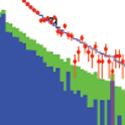Deciphering a bump in the spectrum
An important method for searching for new particles is to look for resonances in the energy spectrum of pairs of charged leptons and their antiparticles emitted from high-energy collisions. Such a resonance can be an indication that a particle has decayed into a lepton-antilepton pair. Lepton resonances generally have a cleaner experimental signature and lower background than similar resonances for hadronic final states. This technique has provided evidence of such particles as the , the , and the boson.
In a paper appearing in Physical Review Letters, the CDF (Collider Detector at Fermilab) Collaboration reports searches for resonances in electron-positron pairs created by high-energy proton-antiproton collisions. Their results place significant limits on particles hypothesized in several popular theories that go beyond the standard model, including a prediction for the graviton and various types of bosons (new gauge bosons that correspond to additional symmetries). They do find a tantalizing indication of a resonance at around : a “bump” or excess of events in that part of the spectrum. The statistical significance is somewhat weak and not strong enough to establish the existence of a particle, but it is strong enough to motivate further searches in this region to confirm or refute the existence of an as yet unknown particle. Although this experiment sees no evidence of the hypothetical particles it searched for, if a new particle is eventually confirmed, theorists will no doubt be scrambling to explain it. – Stanley Brown





